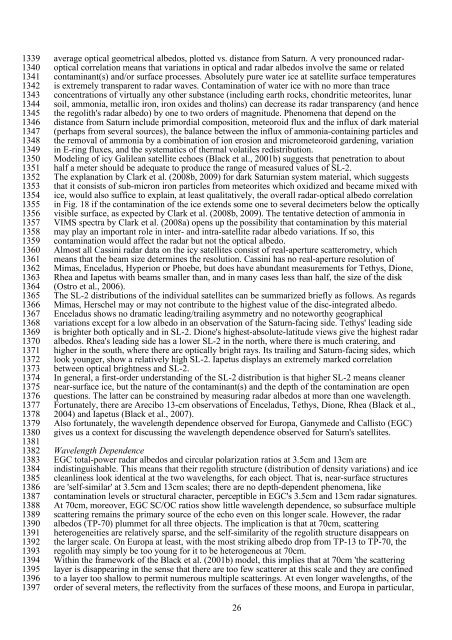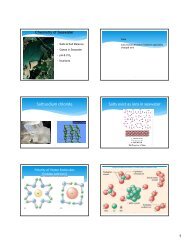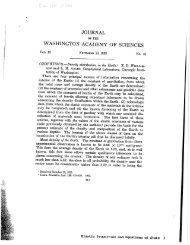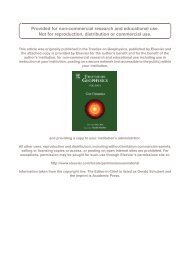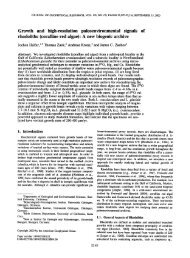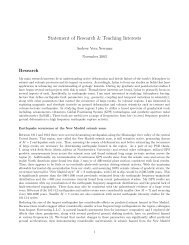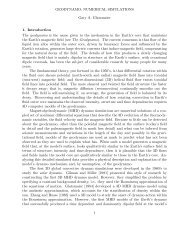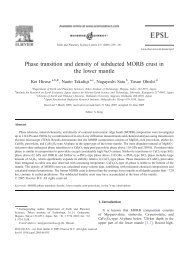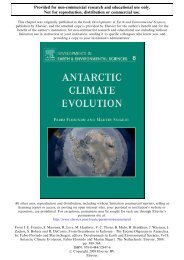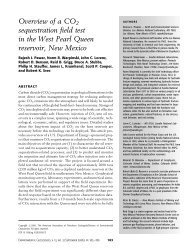Reprint - Earth & Planetary Sciences - University of California, Santa ...
Reprint - Earth & Planetary Sciences - University of California, Santa ...
Reprint - Earth & Planetary Sciences - University of California, Santa ...
Create successful ePaper yourself
Turn your PDF publications into a flip-book with our unique Google optimized e-Paper software.
1339 average optical geometrical albedos, plotted vs. distance from Saturn. A very pronounced radar-<br />
1340 optical correlation means that variations in optical and radar albedos involve the same or related<br />
1341 contaminant(s) and/or surface processes. Absolutely pure water ice at satellite surface temperatures<br />
1342 is extremely transparent to radar waves. Contamination <strong>of</strong> water ice with no more than trace<br />
1343 concentrations <strong>of</strong> virtually any other substance (including earth rocks, chondritic meteorites, lunar<br />
1344 soil, ammonia, metallic iron, iron oxides and tholins) can decrease its radar transparency (and hence<br />
1345 the regolith's radar albedo) by one to two orders <strong>of</strong> magnitude. Phenomena that depend on the<br />
1346 distance from Saturn include primordial composition, meteoroid flux and the influx <strong>of</strong> dark material<br />
1347 (perhaps from several sources), the balance between the influx <strong>of</strong> ammonia-containing particles and<br />
1348 the removal <strong>of</strong> ammonia by a combination <strong>of</strong> ion erosion and micrometeoroid gardening, variation<br />
1349 in E-ring fluxes, and the systematics <strong>of</strong> thermal volatiles redistribution.<br />
1350 Modeling <strong>of</strong> icy Galilean satellite echoes (Black et al., 2001b) suggests that penetration to about<br />
1351 half a meter should be adequate to produce the range <strong>of</strong> measured values <strong>of</strong> SL-2.<br />
1352 The explanation by Clark et al. (2008b, 2009) for dark Saturnian system material, which suggests<br />
1353 that it consists <strong>of</strong> sub-micron iron particles from meteorites which oxidized and became mixed with<br />
1354 ice, would also suffice to explain, at least qualitatively, the overall radar-optical albedo correlation<br />
1355 in Fig. 18 if the contamination <strong>of</strong> the ice extends some one to several decimeters below the optically<br />
1356 visible surface, as expected by Clark et al. (2008b, 2009). The tentative detection <strong>of</strong> ammonia in<br />
1357 VIMS spectra by Clark et al. (2008a) opens up the possibility that contamination by this material<br />
1358 may play an important role in inter- and intra-satellite radar albedo variations. If so, this<br />
1359<br />
1360<br />
contamination would affect the radar but not the optical albedo.<br />
Almost all Cassini radar data on the icy satellites consist <strong>of</strong> real-aperture scatterometry, which<br />
1361 means that the beam size determines the resolution. Cassini has no real-aperture resolution <strong>of</strong><br />
1362 Mimas, Enceladus, Hyperion or Phoebe, but does have abundant measurements for Tethys, Dione,<br />
1363 Rhea and Iapetus with beams smaller than, and in many cases less than half, the size <strong>of</strong> the disk<br />
1364 (Ostro et al., 2006).<br />
1365 The SL-2 distributions <strong>of</strong> the individual satellites can be summarized briefly as follows. As regards<br />
1366 Mimas, Herschel may or may not contribute to the highest value <strong>of</strong> the disc-integrated albedo.<br />
1367 Enceladus shows no dramatic leading/trailing asymmetry and no noteworthy geographical<br />
1368 variations except for a low albedo in an observation <strong>of</strong> the Saturn-facing side. Tethys' leading side<br />
1369 is brighter both optically and in SL-2. Dione's highest-absolute-latitude views give the highest radar<br />
1370 albedos. Rhea's leading side has a lower SL-2 in the north, where there is much cratering, and<br />
1371 higher in the south, where there are optically bright rays. Its trailing and Saturn-facing sides, which<br />
1372 look younger, show a relatively high SL-2. Iapetus displays an extremely marked correlation<br />
1373 between optical brightness and SL-2.<br />
1374 In general, a first-order understanding <strong>of</strong> the SL-2 distribution is that higher SL-2 means cleaner<br />
1375 near-surface ice, but the nature <strong>of</strong> the contaminant(s) and the depth <strong>of</strong> the contamination are open<br />
1376 questions. The latter can be constrained by measuring radar albedos at more than one wavelength.<br />
1377 Fortunately, there are Arecibo 13-cm observations <strong>of</strong> Enceladus, Tethys, Dione, Rhea (Black et al.,<br />
1378 2004) and Iapetus (Black et al., 2007).<br />
1379 Also fortunately, the wavelength dependence observed for Europa, Ganymede and Callisto (EGC)<br />
1380 gives us a context for discussing the wavelength dependence observed for Saturn's satellites.<br />
1381<br />
1382 Wavelength Dependence<br />
1383 EGC total-power radar albedos and circular polarization ratios at 3.5cm and 13cm are<br />
1384 indistinguishable. This means that their regolith structure (distribution <strong>of</strong> density variations) and ice<br />
1385 cleanliness look identical at the two wavelengths, for each object. That is, near-surface structures<br />
1386 are 'self-similar' at 3.5cm and 13cm scales; there are no depth-dependent phenomena, like<br />
1387 contamination levels or structural character, perceptible in EGC's 3.5cm and 13cm radar signatures.<br />
1388 At 70cm, moreover, EGC SC/OC ratios show little wavelength dependence, so subsurface multiple<br />
1389 scattering remains the primary source <strong>of</strong> the echo even on this longer scale. However, the radar<br />
1390 albedos (TP-70) plummet for all three objects. The implication is that at 70cm, scattering<br />
1391 heterogeneities are relatively sparse, and the self-similarity <strong>of</strong> the regolith structure disappears on<br />
1392 the larger scale. On Europa at least, with the most striking albedo drop from TP-13 to TP-70, the<br />
1393 regolith may simply be too young for it to be heterogeneous at 70cm.<br />
1394 Within the framework <strong>of</strong> the Black et al. (2001b) model, this implies that at 70cm 'the scattering<br />
1395 layer is disappearing in the sense that there are too few scatterer at this scale and they are confined<br />
1396 to a layer too shallow to permit numerous multiple scatterings. At even longer wavelengths, <strong>of</strong> the<br />
1397<br />
order <strong>of</strong> several meters, the reflectivity from the surfaces <strong>of</strong> these moons, and Europa in particular,<br />
26


